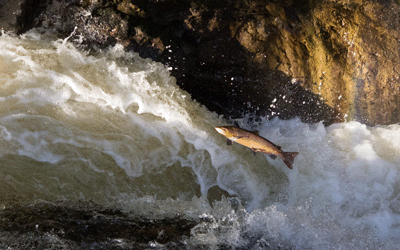Fisheries Management Scotland today launched a suite of 44 fishery management plans at our Annual Conference. The plans have been developed to set out the key actions required to protect and restore Scotland’s wild salmon populations, ranging from specific fisheries management actions to large-scale catchment restoration and actions to improve resilience to climate change.
Fisheries Management Planning provides a framework for District Salmon Fishery Boards (DSFBs) and Fisheries Trusts to document and undertake evidence-based management of Atlantic salmon and sea trout and their fisheries. The plans set out the limiting factors within the fishery and the actions required to overcome them.
Development of the plans was coordinated by Fisheries Management Scotland and delivered by District Salmon Fishery Boards and Rivers and Fisheries Trusts, with support from the Scottish Fisheries Co-ordination Centre. This work was funded by Crown Estate Scotland and the Scottish Government and delivers one of the actions identified in Scotland’s Wild Salmon Strategy Implementation Plan.
The plans were created using ESRI storymaps. This functions like a webpage and allows for interactive map-based data to be integrated into the plan as well as text, photos and videos. These plans were initially designed for a 5-year lifespan, however the ability to review them has been built-in from their inception, allowing government and local managers to assess progress against Scotland’s Wild Salmon Strategy and the accompanying Implementation Plan. One of the benefits of using the online mapping approach is that it allows fisheries management actions right across Scotland can be accessed via a single map, and users can interrogate the dashboard to find out more about issues and solutions in their local area.
The collection of plans and an interactive dashboard of actions are now available to view via the Fisheries Management Scotland website.
This online dashboard allows common actions, themes, pressures and challenges to our fish and fisheries to be identified at a broad range of scales – from local impacts to national pressures. Crucially, this also contains information on the cost of delivering the actions: capital costs, annual costs, in-kind contributions and funding shortfall. Actions for which there are existing Nature Finance markets can be easily identified and will help us to provide an easily accessible bank of projects in need of funding to potential investors.
Sean Robertson, the Scottish Fisheries Co-ordination Centre Manager said:
“It’s been a privilege to lead the fishery management planning project to a very positive successful conclusion. I would like to thank the many partners in this project who have contributed time and energy to bring it to fruition and to thank Crown Estate Scotland and Scottish Government for the crucial funding support, without which this project would not have happened. The tool will transform the way we store, access, present and use data to help us ensure that the decisions we make to conserve our salmon and freshwater fish are based on the best available evidence and will help us prioritise action where it is needed most.”

